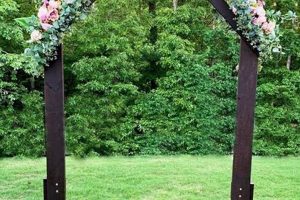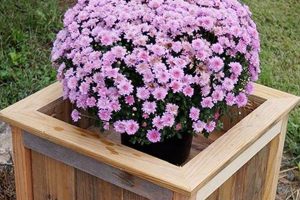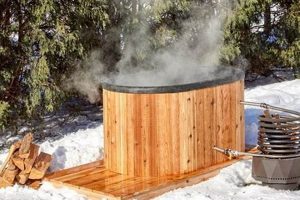The construction of a customized storage unit for footwear, utilizing wood as the primary material and undertaken as a do-it-yourself project, offers a practical solution for organizing shoes. This type of project involves individual design and creation, typically based on readily available plans or original concepts, resulting in a piece of furniture tailored to specific spatial and aesthetic requirements.
Such endeavors provide numerous advantages, including cost savings compared to purchasing pre-made furniture, the opportunity to personalize dimensions and style to complement existing decor, and the satisfaction of creating a functional item. Historically, crafting furniture at home was a common practice, and this contemporary iteration allows individuals to reconnect with traditional skills while addressing modern organizational needs. The benefits extend to sustainable practices, as reclaimed or repurposed wood can be incorporated, minimizing environmental impact.
Subsequent discussion will explore the necessary tools and materials, outline typical construction steps, and present various design ideas for those considering undertaking such a project. Safety considerations and finishing techniques will also be addressed to ensure successful completion and longevity of the resulting storage solution.
Essential Considerations for Wooden Shoe Rack Construction
The following tips outline key considerations for successful fabrication of a wooden shoe rack. Careful attention to these details will contribute to a structurally sound and aesthetically pleasing finished product.
Tip 1: Material Selection: Prioritize wood species based on durability, appearance, and suitability for intended use. Hardwoods, such as oak or maple, offer increased resistance to wear, while softwoods like pine are more cost-effective and easier to work with.
Tip 2: Accurate Measurement and Cutting: Precise dimensions are critical for structural integrity. Employ a measuring tape and a square to ensure accurate cuts, minimizing gaps and misalignments during assembly.
Tip 3: Joint Selection and Construction: Choose appropriate joinery methods based on skill level and desired strength. Options include butt joints reinforced with screws, dado joints for increased stability, or more complex mortise and tenon joints for enhanced durability.
Tip 4: Secure Fastening Techniques: Utilize appropriate screws or nails for the chosen wood type and joint configuration. Pre-drilling pilot holes prevents splitting and ensures secure fastening.
Tip 5: Surface Preparation: Thorough sanding prior to finishing is essential for a smooth and professional appearance. Progress through increasingly finer grits of sandpaper, removing imperfections and preparing the surface for stain or paint.
Tip 6: Finishing Application: Select a finish appropriate for the intended environment and aesthetic preference. Options include varnish for durability, paint for color customization, or oil for a natural look. Apply finish evenly in thin coats, allowing sufficient drying time between applications.
Tip 7: Structural Reinforcement: For larger or more complex designs, consider adding structural reinforcement elements, such as corner braces or additional support beams, to enhance stability and prevent sagging.
Adhering to these recommendations will contribute to the successful creation of a functional and visually appealing storage solution. Proper planning and execution are paramount to achieving desired results.
The subsequent section will delve into potential design variations and customization options for such projects.
1. Design and Planning
Effective design and planning are foundational to the successful completion of any “wooden shoe rack diy” project. These preliminary stages dictate the functionality, aesthetics, and structural integrity of the final product, serving as a blueprint for subsequent construction efforts.
- Space Assessment and Measurement
Accurate assessment of available space is paramount. Measuring the intended location ensures that the shoe rack dimensions are appropriate, preventing issues such as obstruction or inefficient use of space. Examples include measuring closet floors, entryways, or mudrooms to determine maximum height, width, and depth constraints. Precise measurements inform material calculations and design choices, ensuring a practical fit.
- Functional Requirements Analysis
Determining the specific functional requirements dictates the shoe rack’s capacity and configuration. Consider the number of shoes to be stored, the types of footwear (e.g., boots, heels, sneakers), and any desired features such as adjustable shelves or compartments. This analysis guides the selection of appropriate materials and the overall design, ensuring that the completed rack adequately meets its intended purpose.
- Material Selection Considerations
Material selection is a critical element of design and planning. Factors such as wood type (e.g., pine, oak, cedar), thickness, and finish must be considered. Pine offers affordability and workability, while oak provides greater durability. Cedar’s natural insect-repellent properties make it suitable for shoe storage. The choice of material impacts the rack’s appearance, longevity, and structural strength.
- Aesthetic Integration
The design should complement the existing decor. Consider factors such as color, style, and finish to ensure visual harmony. A rustic design might be suitable for a farmhouse-style home, while a minimalist design may better suit a modern aesthetic. The integration of design elements ensures that the rack is not only functional but also aesthetically pleasing, enhancing the overall appearance of the space.
These facets of design and planning demonstrate their integral role in the fabrication process. A thorough understanding and application of these considerations contributes to the creation of a storage solution that is not only practical and durable but also complements its environment, ensuring the effective use of resources and effort in the “wooden shoe rack diy” project.
2. Material Selection
Material selection constitutes a foundational element in any “wooden shoe rack diy” project, directly influencing its durability, aesthetic appeal, and overall cost. The choice of wood species, hardware, and finishing products necessitates careful consideration to ensure the final product meets the intended functional and aesthetic requirements.
- Wood Species Durability
The inherent properties of various wood species dictate the structural integrity and longevity of the storage solution. Hardwoods such as oak or maple offer superior resistance to wear and tear, ideal for high-traffic areas or households with children. Softwoods like pine or fir, while more economical, may be more susceptible to scratches and dents. The selection should align with anticipated usage and desired lifespan.
- Aesthetic Considerations
The visual characteristics of the chosen material significantly impact the overall aesthetic. Different wood types exhibit varying grain patterns, colors, and textures. For example, cherry wood imparts a rich, reddish hue, while birch presents a lighter, more uniform appearance. The selection should complement existing decor and reflect the desired style, whether it be rustic, modern, or traditional. Stains and finishes can further enhance or alter the natural wood characteristics.
- Cost Implications
Material costs represent a substantial portion of the overall project expense. Hardwoods generally command higher prices compared to softwoods. The choice should balance desired durability and aesthetic qualities with budgetary constraints. Exploring alternative materials, such as reclaimed wood or less expensive wood species, can mitigate costs without sacrificing functionality. Comparison shopping and sourcing materials from local suppliers may also yield significant savings.
- Workability and Skill Level
Certain wood species are more amenable to woodworking techniques than others. Softwoods are typically easier to cut, drill, and shape, making them suitable for beginners. Hardwoods require more specialized tools and expertise. The selection should consider the individual’s skill level and available equipment to ensure a smooth and efficient construction process. Opting for pre-cut lumber or simplified designs can also facilitate the process for novice woodworkers.
The interplay between these elements underscores the importance of thoughtful material selection in a “wooden shoe rack diy” undertaking. Aligning material choices with functional needs, aesthetic preferences, budgetary limitations, and skill level ensures a satisfactory outcome, resulting in a durable, visually appealing, and cost-effective storage solution. The choice of these components are fundamental.
3. Joinery Methods
The selection and execution of appropriate joinery methods are paramount in the construction of a durable and aesthetically pleasing wooden shoe rack. These techniques, which involve connecting separate pieces of wood, determine the structural integrity and overall longevity of the finished product. The choice of joinery should align with the design complexity, the intended load-bearing capacity, and the woodworking skill level of the individual.
- Butt Joints
Butt joints represent the simplest form of wood joinery, involving the direct connection of two surfaces end-to-end. While straightforward to execute, butt joints inherently lack significant strength and require reinforcement, typically through the use of screws, nails, or adhesives. In the context of creating storage, butt joints might be suitable for non-load-bearing elements, such as attaching a back panel to a simple frame. However, for supporting shelves or the overall structure, additional reinforcement is essential to prevent failure under weight.
- Lap Joints
Lap joints offer enhanced strength compared to butt joints by overlapping two pieces of wood, effectively increasing the surface area for adhesion and mechanical fastening. This method involves removing a portion of each piece of wood so that they fit flush when joined. In shoe rack construction, lap joints can be employed to create stable frame corners or to join shelf supports to vertical uprights. The increased surface area provides a more robust connection capable of withstanding greater loads than a simple butt joint.
- Dado Joints
Dado joints feature a channel or groove cut into one piece of wood to receive another. This technique provides superior stability and alignment, particularly when constructing shelves or dividers within a shoe rack. The dado joint mechanically interlocks the pieces, preventing lateral movement and distributing weight more evenly across the structure. This method requires precise measurements and cutting to ensure a snug fit, but the resulting joint is significantly stronger and more reliable than simpler alternatives.
- Mortise and Tenon Joints
Mortise and tenon joints represent a traditional and highly durable joinery method characterized by a projecting tenon (tongue) that fits into a mortise (hole) cut into the receiving piece of wood. This technique offers exceptional strength and resistance to stress, making it suitable for load-bearing elements and areas subject to frequent use. While more complex to execute than other methods, mortise and tenon joints provide a robust and aesthetically pleasing solution for connecting frame components or supporting heavy shelves in a wooden shoe rack.
The selection of appropriate joinery methods significantly impacts the structural integrity and longevity of a wooden shoe rack. While simple butt joints may suffice for non-critical components, stronger techniques such as lap joints, dado joints, or mortise and tenon joints are essential for supporting weight and withstanding the rigors of daily use. Careful consideration of the design requirements and individual skill level should guide the selection process, ensuring a durable and functional finished product. The proper execution of these techniques are key to success.
4. Finishing Techniques
Finishing techniques represent a crucial phase in the construction of a wooden shoe rack, directly impacting its aesthetic appeal, durability, and resistance to environmental factors. The application of finishes, such as stains, paints, varnishes, or oils, serves to protect the wood from moisture, UV radiation, and physical abrasion, thereby extending the lifespan of the structure. A poorly executed finish can detract from the overall appearance and compromise the wood’s integrity, leading to premature deterioration. For instance, a wooden shoe rack placed in a humid environment, such as a mudroom, requires a moisture-resistant finish like polyurethane to prevent warping and fungal growth. Conversely, a rack situated indoors may benefit from a penetrating oil finish that enhances the natural grain and provides a softer aesthetic.
The selection of an appropriate finishing technique necessitates careful consideration of the wood species, intended use, and desired aesthetic outcome. Softwoods, such as pine, may require a wood conditioner prior to staining to ensure even color absorption, while hardwoods, like oak, often exhibit a more uniform and predictable response to staining. Furthermore, the application method, whether brush, spray, or wipe-on, influences the final appearance and level of protection. Spray finishes typically provide a smoother, more even coat, while brush application allows for greater control and precision, particularly in intricate designs. In all instances, proper surface preparation, including sanding and cleaning, is essential to ensure optimal adhesion and a flawless finish.
In summation, effective finishing techniques are indispensable to the successful creation of a wooden shoe rack. They not only enhance the aesthetic qualities of the project but also provide essential protection against environmental stressors. Careful consideration of wood species, environmental factors, and desired aesthetic outcomes is necessary to select and apply the most appropriate finishing technique, thereby ensuring the longevity and enduring appeal of the wooden shoe rack. Failure to adequately address this aspect can lead to a compromised and short-lived structure.
5. Structural Integrity
Structural integrity, in the context of a “wooden shoe rack diy” project, refers to the ability of the assembled structure to withstand applied loads and maintain its intended form and function over time. It is a critical factor determining the longevity and safety of the storage solution. Compromised structural integrity can manifest as sagging shelves, wobbly joints, or complete collapse under the weight of stored footwear. These failures not only render the shoe rack unusable but also pose a potential safety hazard, particularly if the rack is located in a high-traffic area.
Several factors contribute to the structural integrity of a wooden shoe rack. Material selection, joinery methods, and the overall design all play crucial roles. For instance, using hardwoods such as oak or maple, as opposed to softwoods like pine, provides greater resistance to bending and compression, particularly under sustained loads. Likewise, employing robust joinery techniques such as mortise and tenon joints or dado joints significantly enhances the rack’s ability to withstand stress compared to simpler methods like butt joints secured with nails. The distribution of weight across the structure, determined by the shelf spacing and support system, also impacts its overall stability. A poorly designed rack, even if constructed from durable materials, may still fail if the load is concentrated in a single area.
In conclusion, structural integrity is a paramount consideration in any “wooden shoe rack diy” project. The selection of appropriate materials, the implementation of sound joinery practices, and a well-conceived design are essential for creating a storage solution that is both functional and safe. Neglecting these aspects can lead to premature failure, necessitating costly repairs or complete replacement. A thorough understanding of structural principles and careful attention to detail are therefore crucial for ensuring the long-term viability and utility of the wooden shoe rack.
Frequently Asked Questions
This section addresses common inquiries related to the design, construction, and maintenance of self-made wooden shoe racks. The information provided aims to clarify potential ambiguities and assist in the successful completion of such projects.
Question 1: What wood species are best suited for shoe rack construction?
The optimal choice depends on factors such as durability requirements, aesthetic preferences, and budgetary constraints. Hardwoods, like oak and maple, provide superior strength and resistance to wear. Softwoods, such as pine, offer a more economical alternative but may require additional protection.
Question 2: How can one ensure adequate structural stability in a self-made shoe rack?
Structural stability is achieved through a combination of appropriate joinery techniques, material selection, and design considerations. Employing robust joinery methods, such as mortise and tenon or dado joints, coupled with the use of durable materials, contributes to the overall stability of the structure.
Question 3: What finishes are recommended for protecting a wooden shoe rack?
The selection of a suitable finish depends on the intended environment and desired aesthetic. Polyurethane coatings offer excellent resistance to moisture and abrasion, making them suitable for high-traffic areas. Oil-based finishes enhance the natural grain and provide a more natural appearance.
Question 4: How can warping or distortion be prevented in a wooden shoe rack?
Warping and distortion can be minimized by using kiln-dried lumber, which has a lower moisture content. Additionally, applying a protective finish to all surfaces helps to prevent moisture absorption. Proper construction techniques and the incorporation of structural supports also contribute to dimensional stability.
Question 5: What tools are essential for constructing a wooden shoe rack?
Essential tools include a measuring tape, a saw (either hand saw or power saw), a drill, a screwdriver, sandpaper, and clamps. Depending on the complexity of the design, additional tools such as a router or a planer may be required.
Question 6: How can a novice woodworker approach a wooden shoe rack DIY project?
Beginners should start with a simple design and utilize readily available plans. Practicing basic woodworking techniques on scrap wood before commencing the actual project is highly recommended. Seeking guidance from experienced woodworkers or online tutorials can also prove beneficial.
These FAQs provide foundational knowledge for embarking on such projects. Proper planning and execution are paramount for achieving a satisfactory outcome.
The subsequent section will delve into advanced design concepts and customization options for those with greater experience.
Concluding Remarks on the Wooden Shoe Rack
This exploration of wooden shoe rack diy has illuminated critical aspects of its design, construction, and long-term maintenance. Emphasis has been placed on material selection, joinery methods, finishing techniques, and structural integrity as determinants of a successful project. The information presented aims to provide a comprehensive understanding of the factors contributing to a functional, aesthetically pleasing, and durable storage solution.
The creation of such a storage unit requires diligent planning, meticulous execution, and a commitment to quality. By adhering to the principles outlined herein, individuals can effectively address organizational needs while engaging in a rewarding and skill-enhancing endeavor. Further research and continued learning are encouraged to refine techniques and explore advanced design possibilities. The creation process offers both practical utility and personal satisfaction.







![[DIY Guide] Easy DIY Wood Window Shutters You Can Build! The DIY Hub: Creative Crafts, Repairs & Life Hacks [DIY Guide] Easy DIY Wood Window Shutters You Can Build! | The DIY Hub: Creative Crafts, Repairs & Life Hacks](https://craftingdiycenter.com/wp-content/uploads/2025/07/th-3579-300x200.jpg)